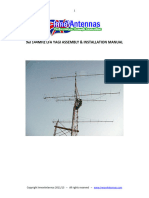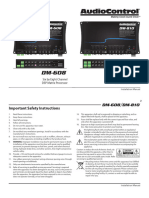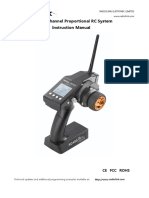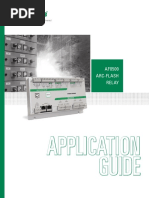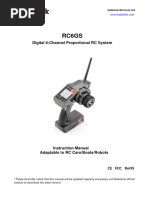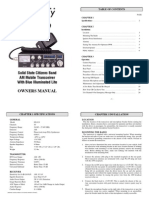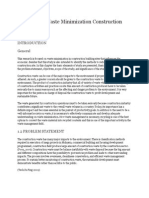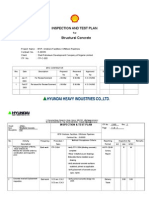Aor La400
Aor La400
Uploaded by
Frank VettelCopyright:
Available Formats
Aor La400
Aor La400
Uploaded by
Frank VettelOriginal Title
Copyright
Available Formats
Share this document
Did you find this document useful?
Is this content inappropriate?
Copyright:
Available Formats
Aor La400
Aor La400
Uploaded by
Frank VettelCopyright:
Available Formats
MAGNETIC LOOP ANTENNA
LA400
Instruction manual
AOR Ltd.
Authority On Radio Communications
Downloaded from www.Manualslib.com manuals search engine
-
2
Downloaded from www.Manualslib.com manuals search engine
Table of contents
1. Introduction ......................................... 4
2. Included in this package . . . . . . . . . . . . . . . . . . . . . . . . . . . . . . . . . 5
3. Hardware setup . . . . . . . . . . . . . . . . . . . . . . . . . . . . . . . . . . . . . . 6
4. Operating instructions . . . . . . . . . . . . . . . . . . . . . . . . . . . . . . . . . . 7
5. Remote tuning system . . . . . . . . . . . . . . . . . . . . . . . . . . . . . . . . . 9
6. Directivity of a loop antenna . . . . . . . . . . . . . . . . . . . . . . . . . . . . . 10
7. Characteristics of a “shielded” loop antenna . . . . . . . . . . . . . . . . 11
8. Options . . . . . . . . . . . . . . . . . . . . . . . . . . . . . . . . . . . . . . . . . . . . . 12
9. Specifications . . . . . . . . . . . . . . . . . . . . . . . . . . . . . . . . . . . . . . . . 13
Downloaded from www.Manualslib.com manuals search engine
1. Introduction
Thank you for purchasing the LA400 Magnetic loop antenna.
To get the best possible results from your LA400, we recommend that you read this manual
and familiarize yourself with the antenna.
Since the invention of this revolutionary concept by KOLSTER in 1915, loop antennas,
especially of the active type, have also been widely used by the military in the 70’s, before
becoming very popular among hobby listeners.
In recent years, the increase in man-made local noise (typical city noise) poses a problem
for the reception of distant signals in the long wave, medium wave and shortwave bands.
LA400 is our latest product based on the technology we developed since the original LA320
loop antenna. In addition to its exceptional directivity in order to minimize the effects of local
noise, the revolutionary LA400 offers, with its REMOTE TUNING SYSTEM, the perfect
solution to keep the antenna away from noise sources by setting it up in quiet areas!
While the control (tuning) box stays at hand’s reach, the loop element can be set away by
using simple LAN and BNC coaxial cables.
10kHz to 500MHz, 5 position band switch to peak only on the wanted signal. Small size
30.5cm diameter loop with exceptional 20dB gain
Remote tuning – Unlike previous amplified indoor loop antennas, the band switching and
fine tuning controls are not tied anymore to the loop element. With these controls now on
the control box and by using the LA400-RCK optional extension cables, it is now possible
to tune the antenna while the loop element is setup at the most reception friendly location
possible (window, covered balcony, etc...). Compatible with 3rd party cables. Maximum
length: 20m. (Minimum input voltage 12V when using an extension)
A relay system is used for band switching, providing excellent isolation characteristics.
The relay is efficiently placed inside the loop element, while you can operate it through the
control box via the control cable.
Electronic tuning from 150kHz 〜 30MHz allows very sharp tuning to the desired
frequency. Shift the aligning point slightly to attenuate unwanted signals while amplifying
the wanted signal.
Downloaded from www.Manualslib.com manuals search engine
2. Included in this package
No. Description Qty
① Loop element 1
② Control box 1
③ Control cable (LAN type) 30cm 1
④ 1m coaxial cable (RG-58U with BNC (F)/BNC (F) connectors) 1
⑤ AC power supply 1
⑥ This printed instruction manual 1
① ④
② ⑤
Downloaded from www.Manualslib.com manuals search engine
3. Hardware setup
Caution!
LA400 is a RECEIVE ONLY antenna. Do not transmit with it or its circuitry will be severely
damaged, maybe even beyond repair.
As explained on the diagram below, attach the loop element to the control box, then connect
the coaxial and control cables. Finally, connect the AC power supply.
To connect LA400 to an antique receiver with 600Ω antenna terminal, use the optional
MC-600 Impedance Matching Transformer.
Loop element
To antenna input socket
Control box
of your receiver
Coaxial cable Control cable AC power supply
Downloaded from www.Manualslib.com manuals search engine
4. Operating instructions
◎ Connect the AC power supply and push the red power button on the control box. A blue
LED will light up.
◎ Tune your receiver to the desired frequency.
◎ Now you need to select one of the 5 available band ranges, using the band switch
numbered from 1 to 5. Refer to the printed switch number / band range information on
the top of the control box.
Please note that position 5 is non-tunable, as the loop is wired to act as an amplified
whip antenna.
5 selectable bands
10kHz to 150kHz
&
30MHz to 500MHz.
Band switch
Downloaded from www.Manualslib.com manuals search engine
◎ Peak the received signal by turning the TUNING knob slowly to either the left or the right.
The white dot on the tuning know helps you to see the approximate location of the tuning.
For your reference, when the dot is on top as on the above illustration, the tuning PEAK
is approximately in the middle of the selected band.
For example for band switch position 3 (3MHz to 10MHz), it would be roughly peaked on
6.5MHz.
Tuning is most critical above 3MHz. For best performance of LA400 and optimal
reception conditions, make sure the selected band is appropriate for the received
frequency, and search for the signal peak with the tuning knob.
◎ A loop antenna is very directional. Rotate the loop element until your receiver’s signal
strength meter (S-meter) deflects to maximum and the incoming signal sounds clearest.
If your receiver does not have an S-meter, simply adjust for maximum received signal.
Rotate the loop element until the signal is strongest and any interfering signal is nulled.
Downloaded from www.Manualslib.com manuals search engine
5.Remote tuning system
With its unique REMOTE TUNING SYSTEM, the band switching and fine tuning controls are
not tied anymore to the loop element. With these controls now on the control box and by
using the optional LA400-RCK extension cables, it is now possible to tune the antenna while
the loop element is setup at the most reception friendly location possible (window, covered
balcony, etc...).
You can of course use generic straight LAN and RG-58U 50Ω coaxial cables. Maximum
length: 20m each. Minimum input voltage 12V when using an extension.
Please note that TUNING knob positions might vary depending on the length of the remote
cables. This is due to slight variations of the voltage supplied to the loop element, depending
on the length of the remote cables. This is not a malfunction and does not diminish the
antenna’s performance.
For optimal reception conditions, always try to setup the loop antenna as far away as
possible from noise sources such as switching power supplies, TVs, computers, etcJ
Ideal locations to remotely setup the loop element are
windows, curtain rails and even better, covered balconies, as
long as the loop element does not get wet!
Remember that LA400 is NOT WATERPROOF!
It is highly advised to put the loop antenna back indoors, after
use.
For window mounting, it is a good idea to use a
(non-supplied) plastic suction hook, as illustrated here.
Alternatively you can also use a (non-supplied) nylon cord to
hang it to a curtain rail.
Downloaded from www.Manualslib.com manuals search engine
6. Directivity of a loop antenna
A significant advantage of a loop antenna is its directional pattern, a “figure 8” shape with
two null points separated by 180 degrees. The null in reception that is located at right angles
to the plane of the loop can be used for interference reduction. On the other hand, received
signal strength is greatest in the directions indicated by the arrows.
Horizontal radiation pattern of LA400
NULL
NULL
NULL: Angle from which magnitude of the radiation pattern decreases to zero. In other words, these are the
sides from which the antenna receives the least.
Maximum reception performance is achieved when these sides of the loop face the signal.
10
Downloaded from www.Manualslib.com manuals search engine
7. Characteristics of a “shielded” loop antenna
A shielded loop antenna is less susceptible to nearby electrical interference sources, thanks
to the electrostatic shielding of the loop afforded by the grounded metallic conduit enclosing
the wire coils.
By these principles, LA400 responds to the magnetic field rather than the electric field, thus
efficiently isolating the low frequency electrostatic noise from the distant signal to be
received.
Shield circuit of LA400
With this design, all parts of the loop will have the same capacitance to ground. The shield
also protects the loop from the induction field created by nearby disturbances. The induction
field refers to the electric and magnetic fields in the immediate vicinity of an antenna. Those
fields decrease rapidly in strength with distance, and the induction field is usually ignored.
However, wires and other metal objects near the loop can take energy from a passing wave
and produce induction fields that can induce spurious voltages in the loop.
A shield over a loop antenna will not appreciably decrease the amount of magnetic flux that
passes through the loop when a wave goes by - as long as it does not form a complete turn.
A gap is left in the shield so that it does not become a shorted turn. Without the gap, the
shield would reduce the magnetic field linking the loop so that no signal could be received by
the internal wire. With the gap, alternating currents can be induced in the metal shield and
voltages will be induced in the internal wire.
11
Downloaded from www.Manualslib.com manuals search engine
8. Options
LA400-RCK Extension cables (10m each)
This set of cables allows you to separate the
control (tuning) box from the loop element, by up
to 10m. Conveniently place the loop element as
closely as possible to an open space, such as
window, covered balcony, etc...away from local
electrical noise, for a quieter reception
experience.
MC-600 Impedance matching transformer
Passive impedance matching transformer interface which allows
your LA400 to be connected to any antique receiver with a 600Ω
antenna terminal. Supported frequency range: 10kHz to 30MHz.
MC-600 has the same isolation feature than the GT-1 accessory
described below.
GT-1 Galvanic isolation transformer
To be connected between the receiver and the LA400 antenna.
Does greatly reduce local noise by breaking the ground loop
effect between antenna and receiver, especially when the
LA400-RCK 10m separation cables are used.
Supported frequency range: 40kHz to 30MHz
12
Downloaded from www.Manualslib.com manuals search engine
9. Specifications
LA400 Magnetic loop antenna
Frequency range 10kHz 〜 500MHz
Aligned range 150kHz 〜 30MHz 4 band selectable
Unaligned range 10kHz 〜 150kHz, 30MHz 〜 500MHz
Gain 20dB min.
Operating temp. -10℃ 〜 +60℃
Power req. 9〜15V DC, 80mA @ 12VDC
(Min. input voltage 12V when using an extension)
Impedance 50Ω
Loop 305mm diameter
Sizes (mm) Loop element 305(W)x367(H)x38(D)
projections incl. Control box 118(W)x59(H)x112(D)
All assembled 300(W)x425(H)x110(D)
Loop element 220g
Weight
Control box 300g
Control cable (LAN type) 30cm
Supplied AC power supply
accessories BNC (F)/BNC (F) RG-58U coaxial cable (1m)
Printed user manual
LA400 is NOT intended for transmit purposes!
Not waterproof, use only indoors.
Product specifications and design subject to change without prior notice.
13
Downloaded from www.Manualslib.com manuals search engine
Memo:
- 14
Downloaded from www.Manualslib.com manuals search engine
-
15
Downloaded from www.Manualslib.com manuals search engine
®
AOR Ltd.
2-6-4 Misuji, Taito-ku, 111-0055 Tokyo, Japan
Authority On Radio Communications www.aorja.com
- (Sept.25, 2013)
16
Downloaded from www.Manualslib.com manuals search engine
You might also like
- M.P. Tourism Board - RFPZonalMasterPlanEcoSensitiveZonesCluster5updatedDocument58 pagesM.P. Tourism Board - RFPZonalMasterPlanEcoSensitiveZonesCluster5updatedAmeesha Soni100% (1)
- Keb Combivert f4 Power Stage Instruction ManualDocument52 pagesKeb Combivert f4 Power Stage Instruction ManualsrikrishNo ratings yet
- LA400 Manual Antenna ActiveDocument14 pagesLA400 Manual Antenna Activedenivaldo2009No ratings yet
- InnovAntennas 9el-144-LFA-ASSEMBLY-V3-Non-ABDocument14 pagesInnovAntennas 9el-144-LFA-ASSEMBLY-V3-Non-ABsboonuy331No ratings yet
- TC 500Document77 pagesTC 500Lucas CouraNo ratings yet
- Ep 400Document15 pagesEp 400khoasunpacNo ratings yet
- TC 610Document95 pagesTC 610leosedfNo ratings yet
- 06-Radio_interphony_link-01Document31 pages06-Radio_interphony_link-01Ariel BecerraNo ratings yet
- Bc350a ManualDocument28 pagesBc350a Manualhayden.foy3No ratings yet
- Icom - IC-F410 - Service - Manual Ok Enviar CorreoDocument41 pagesIcom - IC-F410 - Service - Manual Ok Enviar Correoluis enrique saiz ortizNo ratings yet
- MC 111 CsDocument20 pagesMC 111 Csdomador1624No ratings yet
- Icf 310Document42 pagesIcf 310jessica.murfeNo ratings yet
- Active Monopole Antennas Operation ManualualDocument15 pagesActive Monopole Antennas Operation Manualualmid_cycloneNo ratings yet
- Service Manual: VHF Marine TransceverDocument50 pagesService Manual: VHF Marine TransceverRoyal Revolt 01100% (1)
- Fluke199XRAY: Users ManualDocument22 pagesFluke199XRAY: Users ManualAndres CañaveralNo ratings yet
- 40 FfacDocument24 pages40 FfacRetro PrimeNo ratings yet
- 05-Interphony-01Document24 pages05-Interphony-01Ariel BecerraNo ratings yet
- LM2660 Switched Capacitor Voltage Converter: 1 Features 3 DescriptionDocument27 pagesLM2660 Switched Capacitor Voltage Converter: 1 Features 3 Descriptione_kobeNo ratings yet
- CRT Micron, Dual Band Transceiver 144-146 MHZ RX/TX 430-440 MHZ RX/TXDocument37 pagesCRT Micron, Dual Band Transceiver 144-146 MHZ RX/TX 430-440 MHZ RX/TXSara VigárioNo ratings yet
- 04-Radio_paging-01Document38 pages04-Radio_paging-01Ariel BecerraNo ratings yet
- T 407ownersDocument8 pagesT 407ownersAleksandar BilakNo ratings yet
- GENERADOR INSTEK Gfg8215aDocument37 pagesGENERADOR INSTEK Gfg8215alabca laboNo ratings yet
- Liberator V1000 User ManualDocument85 pagesLiberator V1000 User ManualMalc SellarsNo ratings yet
- p52391 System9 OmDocument8 pagesp52391 System9 OmSavage GraffixNo ratings yet
- Noyafa NF300 User ManualDocument12 pagesNoyafa NF300 User ManualguecorandyNo ratings yet
- FS-T4A - Manual (HK - T4A) - Rádio PDFDocument15 pagesFS-T4A - Manual (HK - T4A) - Rádio PDFMarckos FrancoNo ratings yet
- S000105445en 2Document6 pagesS000105445en 2Gökmen ŞirinNo ratings yet
- F600Document36 pagesF600John GriffithsNo ratings yet
- Rci-2950 Rci-2970 - 150: DX DXDocument11 pagesRci-2950 Rci-2970 - 150: DX DXbellscb100% (2)
- DM Series ManualDocument48 pagesDM Series ManualjamescshehornNo ratings yet
- LA 3A ManualDocument22 pagesLA 3A Manualлюсиен лазаровNo ratings yet
- 400 ProDocument36 pages400 ProJadi PurwonoNo ratings yet
- User Guide For The Alpha Loop JR+ AntennaDocument8 pagesUser Guide For The Alpha Loop JR+ AntennaMar CabNo ratings yet
- RC4GS User Manual-2017.6.7Document28 pagesRC4GS User Manual-2017.6.7seregio12No ratings yet
- User Manual: AN5506-01-A GPON Optical Network UnitDocument24 pagesUser Manual: AN5506-01-A GPON Optical Network Unitdexterlab13No ratings yet
- Lc-2400a User ManualDocument121 pagesLc-2400a User Manualmuhammad nidzwanNo ratings yet
- SF3015G LáserDocument32 pagesSF3015G LáserMario CNo ratings yet
- Apollo Ap400Document12 pagesApollo Ap400Frank FlyshellNo ratings yet
- 1khw002584be Tuning of Etl600r4 RX RF Filter p4rxDocument8 pages1khw002584be Tuning of Etl600r4 RX RF Filter p4rxfayssal salvadorNo ratings yet
- Service Manual: i756PRO™Document105 pagesService Manual: i756PRO™getulioNo ratings yet
- RadioPopper P1 ManualDocument17 pagesRadioPopper P1 ManualRadioPopperNo ratings yet
- ACOM 1010 ManualDocument20 pagesACOM 1010 ManualEdmilson Espindola Dos SantosNo ratings yet
- Manual Icom IC F121SDocument74 pagesManual Icom IC F121SJorge RobertoNo ratings yet
- LM 2586Document43 pagesLM 2586Cristobal MartinezNo ratings yet
- VHF Marine Transceiver: S-14720XZ-C1 Apr. 2011Document27 pagesVHF Marine Transceiver: S-14720XZ-C1 Apr. 2011song_trangNo ratings yet
- Application Guide: AF0500 Arc-Flash RelayDocument20 pagesApplication Guide: AF0500 Arc-Flash RelayRajendra Prasad ShuklaNo ratings yet
- RC6 GSManualDocument31 pagesRC6 GSManualJavier GallegoNo ratings yet
- IC-M402 Service ManualDocument42 pagesIC-M402 Service ManualRicardoNo ratings yet
- 0613 First Look Aorla 400Document2 pages0613 First Look Aorla 400David RossNo ratings yet
- Lm2674 Simple Switcher Power Converter High Efficiency 500-Ma Step-Down Voltage RegulatorDocument35 pagesLm2674 Simple Switcher Power Converter High Efficiency 500-Ma Step-Down Voltage RegulatorTécnico 04 LógicaNo ratings yet
- Faxl200 Faxl280Document212 pagesFaxl200 Faxl280claudiuparaNo ratings yet
- pwl41xxs - Man - 03 - 06 - en 2006Document50 pagespwl41xxs - Man - 03 - 06 - en 2006HungNguyenVietNo ratings yet
- Bachmann k27 Installation Guide Phoenix SoundDocument20 pagesBachmann k27 Installation Guide Phoenix SoundMontheardNo ratings yet
- AnyTone 878 User ManualsDocument54 pagesAnyTone 878 User ManualsAlexandru ȘtefănițăNo ratings yet
- Aer Colourizer EngDocument12 pagesAer Colourizer EngAntonello CarusoNo ratings yet
- Owners Manual: Solid State Citizens Band AM Mobile Transceiver With Blue Illuminated LiteDocument11 pagesOwners Manual: Solid State Citizens Band AM Mobile Transceiver With Blue Illuminated LitebellscbNo ratings yet
- Guardian™ Serial Radio Modem: User ManualDocument71 pagesGuardian™ Serial Radio Modem: User Manualsr pNo ratings yet
- BDA C3000 (5018375) - PRINT - PDF Release 1.0: Downloaded From Manuals Search EngineDocument8 pagesBDA C3000 (5018375) - PRINT - PDF Release 1.0: Downloaded From Manuals Search EngineAbdalhakeem Al turkyNo ratings yet
- Tyt TH Uv8000e Users ManualDocument58 pagesTyt TH Uv8000e Users ManualjohnnikitasNo ratings yet
- KippZonen InstructionManual AMPBOX Signal Amplifier V1102Document28 pagesKippZonen InstructionManual AMPBOX Signal Amplifier V1102luismimarNo ratings yet
- Cu Mica Xlpe Os Swa LSHFDocument2 pagesCu Mica Xlpe Os Swa LSHFNabeelNo ratings yet
- LZ3 Servo Driver Driver User Manual - LanzeDocument43 pagesLZ3 Servo Driver Driver User Manual - LanzeMURAT ORMANNo ratings yet
- Cost ManagementDocument27 pagesCost Managementfariha.swarna09No ratings yet
- LESSON PLAN PLC 4fDocument3 pagesLESSON PLAN PLC 4fleonilla82No ratings yet
- Mix Design and Calculation of Cement For Different Grades of ConcreteDocument12 pagesMix Design and Calculation of Cement For Different Grades of ConcreteKENNYNo ratings yet
- CSCI 1480 University of Central Arkansas Bonus Lab (Optional)Document13 pagesCSCI 1480 University of Central Arkansas Bonus Lab (Optional)Michael WilsonNo ratings yet
- Diode Circuit Analysis: - Goal: Find Quiescent Operating Point (Q-Point) of The Diode (,) - Analytical ToolsDocument13 pagesDiode Circuit Analysis: - Goal: Find Quiescent Operating Point (Q-Point) of The Diode (,) - Analytical Toolssanjayb1976No ratings yet
- Teory and The Princess and The Frog AnalyzesDocument9 pagesTeory and The Princess and The Frog AnalyzesYuda BrilyanNo ratings yet
- The Origins of Electronic MusicDocument12 pagesThe Origins of Electronic MusicMatt Christoph100% (5)
- Deluge System Data SheetDocument2 pagesDeluge System Data Sheethaseeb parkarNo ratings yet
- Folkstone Warren LandslidesDocument31 pagesFolkstone Warren LandslidesHestor DavidNo ratings yet
- Deforestation Management System Using Force and SoundDocument4 pagesDeforestation Management System Using Force and SoundManeesh SvsNo ratings yet
- Click For More Books: Scanned With CamscannerDocument43 pagesClick For More Books: Scanned With CamscannerRazvi Gulam KhanNo ratings yet
- Electrical PlanDocument8 pagesElectrical PlanMayvrick SangacenaNo ratings yet
- DHH Child Admission Screening FormDocument2 pagesDHH Child Admission Screening FormSabira ShakirNo ratings yet
- Operating Manual For RiCAD 3DDocument11 pagesOperating Manual For RiCAD 3DlexmartinezNo ratings yet
- The Re-Enchantment Way Temporal ExperimeDocument94 pagesThe Re-Enchantment Way Temporal Experimegensai kNo ratings yet
- Diala White PaperDocument12 pagesDiala White PaperRichard SyNo ratings yet
- Training ReportDocument72 pagesTraining Reporttharindu pathirajaNo ratings yet
- Never Let Me GoDocument6 pagesNever Let Me GoBeepo100% (1)
- Promoting Your Guest HouseDocument1 pagePromoting Your Guest Housemazri_hafiz7574No ratings yet
- Noel ReferenceDocument3 pagesNoel ReferenceNoel L. Fullo Jr.No ratings yet
- Planificacion 10mo 2023 INGLESDocument21 pagesPlanificacion 10mo 2023 INGLESMaría Isabel GarcíaNo ratings yet
- Extended Daycare Registration FormDocument1 pageExtended Daycare Registration FormSir CalaqueiNo ratings yet
- How To Reclaim The Sovereignty of Your Mind - Humans Are Free (Humans Are Free) (Z-Library)Document5 pagesHow To Reclaim The Sovereignty of Your Mind - Humans Are Free (Humans Are Free) (Z-Library)sarapmaria97No ratings yet
- Abyip 2020 Basak - FinalDocument14 pagesAbyip 2020 Basak - FinalWarren Paraon Maitel100% (5)
- Waste Minimization On Construction SitesDocument49 pagesWaste Minimization On Construction Siteskens247No ratings yet
- OSS K-6 After School Club Guide 24-25Document26 pagesOSS K-6 After School Club Guide 24-25daveedriffoNo ratings yet
- ITP C 005 (Structural Concrete)Document4 pagesITP C 005 (Structural Concrete)segun ajibolaNo ratings yet



